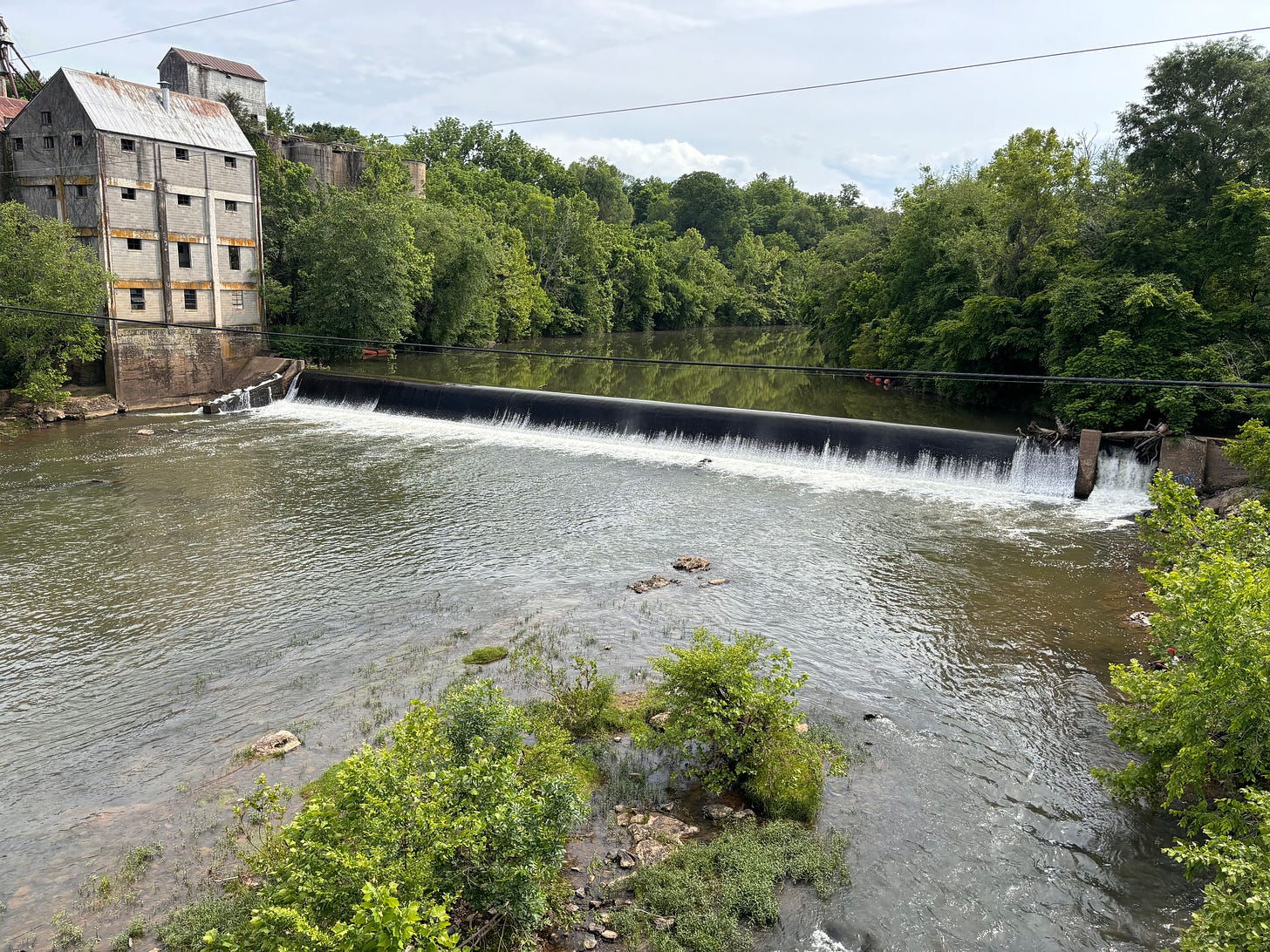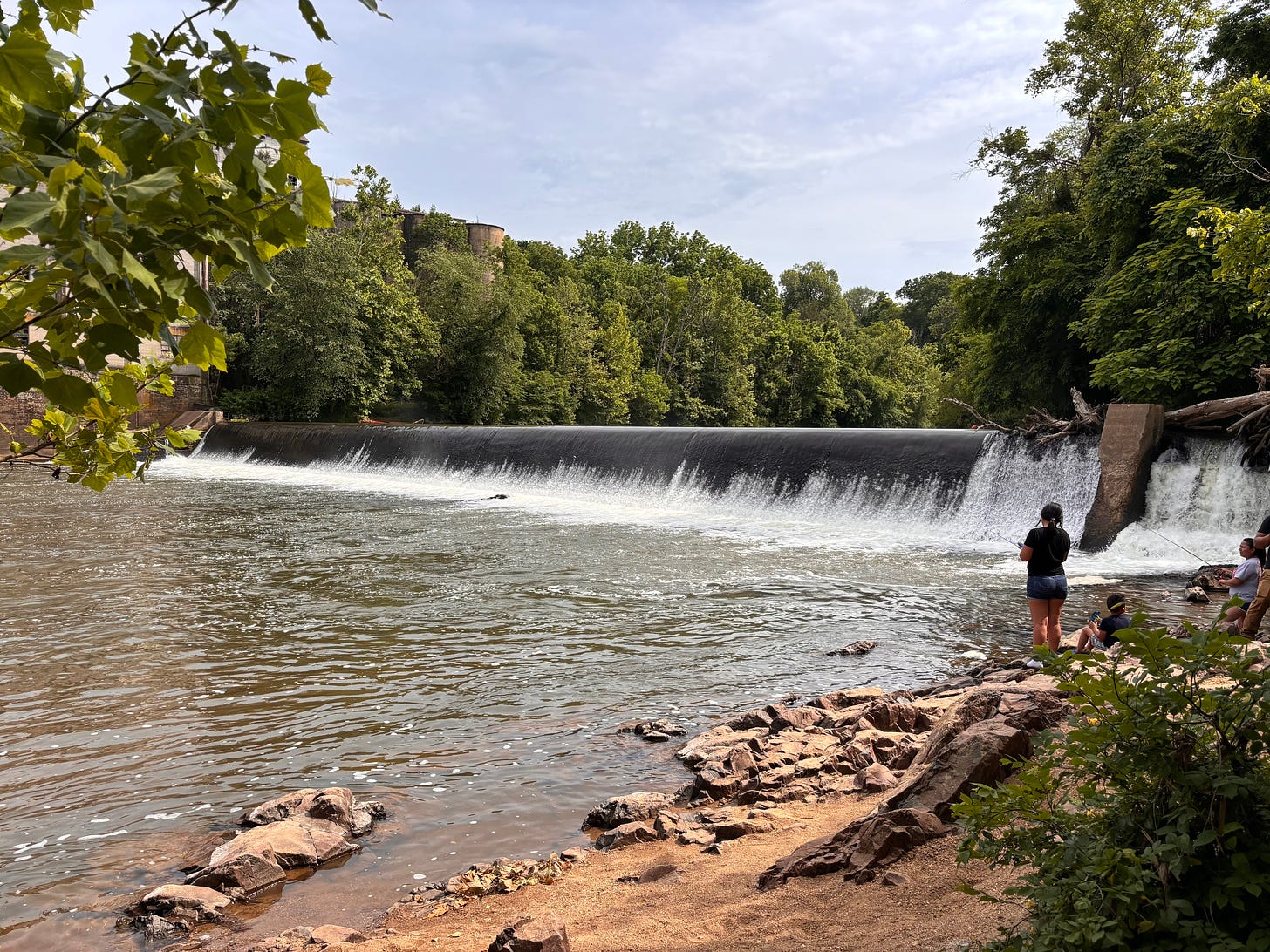The water flowing over the Rapidan River dam sets a mood and tells a story. On wild, rainy days, I’ve gone to the bridge spanning Orange and Culpeper counties to take pictures of the current roaring straight out from the dam—a flood in progress. During dry spells, I’ve gazed at the dam in consternation as a mere trickle crept over its edge. But no matter what the weather’s like, I always glance at that aged concrete structure to check the river’s pulse.
Now, word comes from American Climate Partners (ACP) that the dam is slated for removal. If this comes to pass, the river will be telling a new story of enormous interest to local residents and conservationists alike.
According to an ACP press release, National Oceanic and Atmospheric Administration (NOAA) Fisheries has awarded ACP’s Rapidan Fish Passage Project $7.9 million in funding: “The project will remove the Rapidan Mill Dam and restore habitat along the Rapidan River in the lower Chesapeake Bay watershed. Removal of the dam will open more than 500 miles of habitat for American shad, river herring, and other migratory fish. The project will also benefit the local community by increasing recreational and subsistence fishing opportunities, improving public access to the river, reducing the risk of flooding, and removing aging infrastructure.”
The announcement notes that NOAA funding for the first year will total $1.5 million. Work will include data collection and development of “an engineering design plan and timeline for dam removal and the stabilization and restoration of the stream banks,” plus submission of required federal and state permit applications and at least two public meetings about the project. During the next two years, up to $6.4 million will cover the actual removal of the dam, “historic resources mitigation,” and at least two more public meetings each year.
In an email exchange with me, ACP Executive Director Mike Collins said he plans to hold the first public information session this fall, in either Rapidan or Orange.
In 2022, ACP Realty Holdings LLC, a subsidiary of ACP, bought the dam and some land on its Culpeper side from the previous owners, Robert O’Brien and his son, Kevin O’Brien. ACP has its headquarters in the renovated mill office adjacent to the old mill on the Orange County side of the bridge. The self-described “entrepreneurial”nonprofit is well-known for its successful StreamSweepers program, whose workers have removed huge quantities of old tires and other debris from the Rapidan and other Virginia rivers.
View from the bridge of the dam and the old mill in Rapidan.
Quoting from his organization’s NOAA grant proposal, Collins explained that getting rid of the dam will free up water on both the Rapidan and Robinson rivers “and all associated accessible tributaries.” In addition to the shad and the herring, the American eel and the sea lamprey stand to benefit from a dam-free zone.
ACP’s grant application offers more details: “[T]there is a functional, but untested, Denil fishway [fish ladder] on a smaller dam about 9 miles upstream on the Rapidan. When that fishway was built in 2003, the Chesapeake Bay Program claimed the reopening of 511 miles to resident fishes at that time. When Rapidan Mill Dam is removed or altered and the Denil fishway can be evaluated for migratory fish use, that 511 miles will also be reopened for migratory fish.”
Collins expects to sign the formal agreement with NOAA in September and complete the project in 3-4 years, provided all the government permits come through.
The first year to year-and-a-half of preparatory work will be crucial to the project’s success since that’s when Collins and his team will decide exactly how to free up all those miles of river water for the traveling fish. In previous discussions, he has mentioned the possibility of removing just part of the dam, in the middle, rather than blasting out the whole thing. Inevitably, cost will be a factor.
The impact of releasing the water backed up behind the dam raises a big question, but Collins has a ready answer: “As for dewatering the pool behind the dam, the intent will be to slowly lower the water levels over time using the flow control structure at the Culpeper County end of the dam.”
80 U.S. dams removed in 2023
ACP’s project is part of a growing environmental trend. According to American Rivers, an organization devoted to river restoration, 80 “outdated, unsafe and uneconomical” dams were removed in 25 states in 2023.
In an article titled “Remove 30,000 Harmful Dams,” American Rivers makes its case: “Damming rivers and blocking their natural flows has destroyed the habitat that fish, birds, and wildlife need to nest, feed, reproduce, and thrive. Habitat degradation is the #1 cause of extinctions. And as they age, dams put people in harm’s way of catastrophic flooding.”
And that’s not all, the conservationist group argues: “Damming more rivers is not a tenable water-supply solution in the face of climate change. Toxic algae outbreaks in warm, stagnant reservoirs contaminate water supply. Decaying plant matter in reservoirs produces large amounts of methane, a greenhouse gas 30 times more harmful than carbon dioxide.”
Despite the purported benefits of dam removal, Orange County resident and outdoorsman Andy Hutchison is not sold on ACP’s ambitious plans. He wrote me, “The issues I have with the removal of the dam are environmental, primarily the release of invasive blue catfish and snakeheads. These fish will be in the river year-around at the expense to native fish for the benefit of [migrating] fish to spawn once a year. The dam dates back to the 1700s, and shad were plentiful from then until the mid- to late 1900s, leading to the conclusion the dam is not the problem.”
Gary Jones, the Rapidan Fire Department’s treasurer and an avid supporter of Rapidan, is also concerned. He told me that he’s curious to know whether ACP has really figured out how to make sure the migratory fish have the open passageway they need—otherwise, the whole deal will be a bust.
My informal conversations indicate that some locals are worried about ACP’s desire to increase public access to the river. There is concern that an influx of day-trippers might park on private property and add to an already-vexing litter problem.
Longtime Rapidan resident Cynthia DeCanio has a different take. “I know many people will be upset about this news as the dam is near and dear to their hearts,” she wrote to me. However, she expects the river’s next big story will be a happy one. “After the 1995 flood, Friends of the Rappahannock hired me to coordinate stream bank restoration in the Rapidan River watershed. During that time, the Embrey Dam in Fredericksburg was taken down, which meant that the last barrier to a free-flowing river giving fish access to their spawning grounds was the Rapidan dam. I believe taking down the dam is a good decision and will eventually benefit Rapidan. Hopefully, a free-flowing river will be beautiful to behold.”
Families fish in the Rapidan River below the dam on a recent afternoon.




Great article, Hillary, I did not know all this history and will now pay much more attention to Rapidan issues.
I didn't see any shad or herring in the Rapidan at Germanna during the shad run (miles below the dam). Water is very clear also. Seem like a specious reason to knock down the damn.